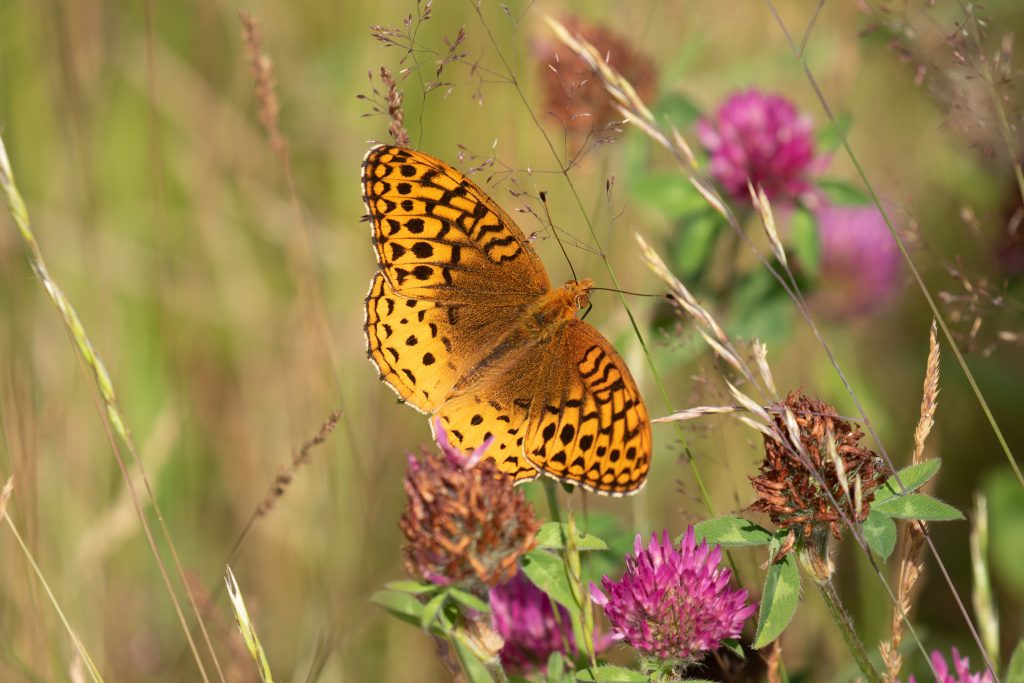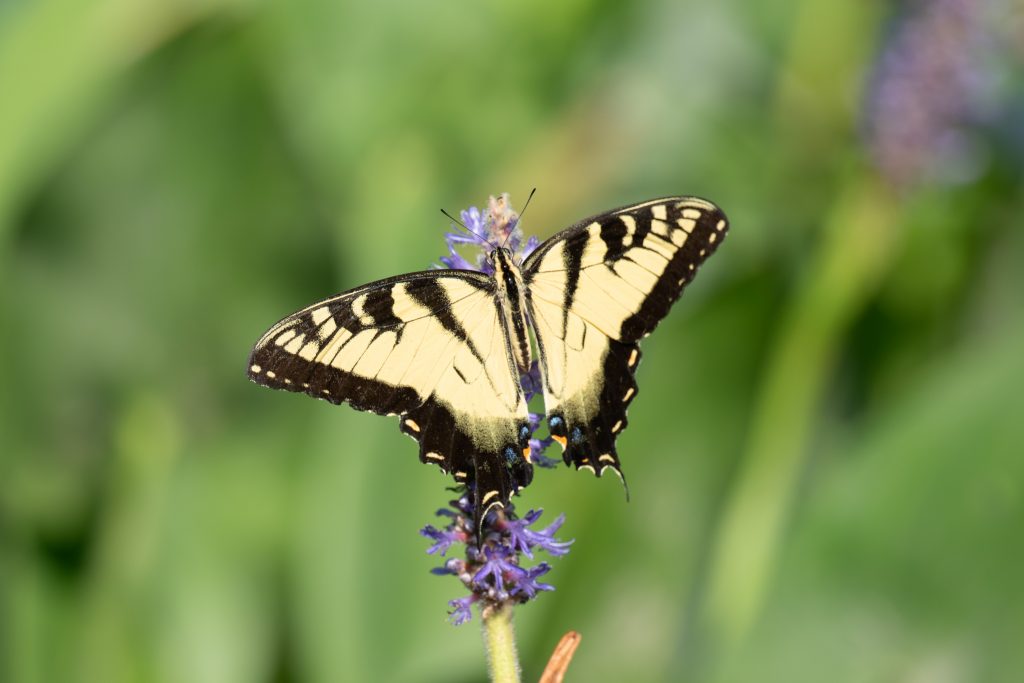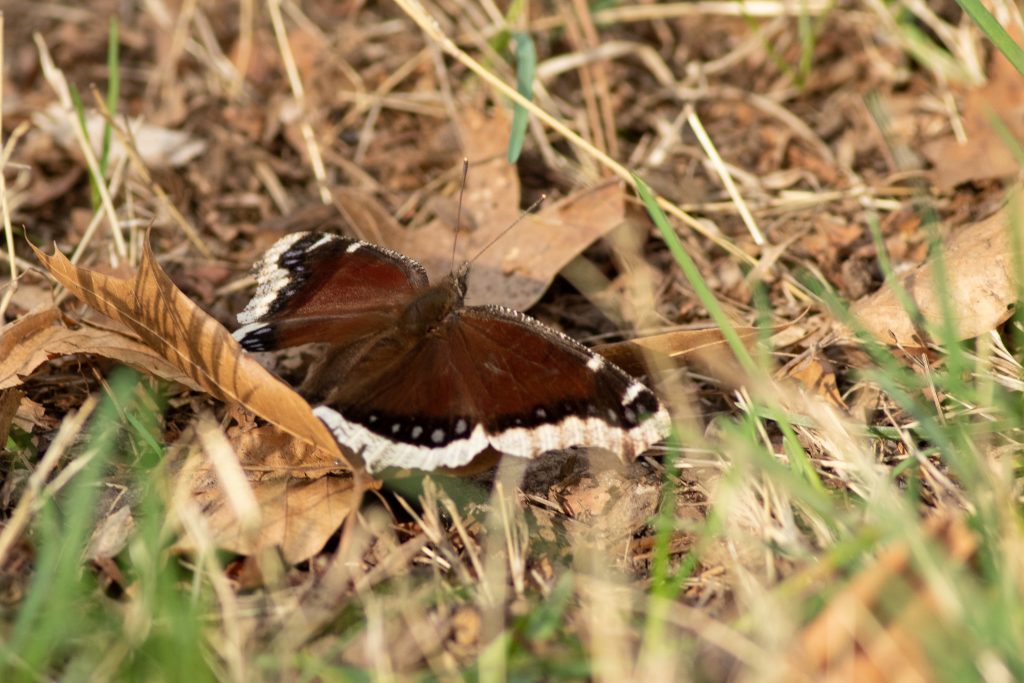You likely learned in grade school, from Heimlich in a Bug’s Life, or from the Very Hungry Caterpillar, that every butterfly undergoes metamorphosis. For all butterflies, this phenomenon involves four distinct stages of development. An individual starts as an egg, breaks out as a caterpillar (or larva), eats leaves until it’s ready to pupate into a chrysalis, and subsequently emerges as an adult butterfly. Adults fly around to mate, feed on flower nectar, and produce the next generation. A successful butterfly not only has to make the transition from egg to larva, pupa, and eventually adult, but in New England, also has to endure six months of cold, harsh conditions. So how do such delicate creatures make it through the winter?
Well, the answer depends on which of New England’s 100+ species of butterflies we consider!
Some butterflies spend the winter as small, immobile, and defenseless eggs. Once such species is the bog copper Lycaena epixanthe which thrives in undisturbed cranberry bogs of New England such as those found on Cape Cod. Adults lay eggs on the bottom of cranberry leaves near the surface of the bog. These eggs are built to withstand not only winter freezes and thaws, but also periodic flooding. Caterpillars break out of their eggs in the spring and begin chowing down on cranberry leaves, their favorite food. Other gossamer-wing butterflies like Coral Hairstreak Satyrium titus and Oak Hairstreak Satyrium favonius spend the winter as eggs on their favorite trees, black cherry (Prunus serotina) and oaks (Quercus spp.), respectively. Eggs are situated safely in the crevasses of the tree bark and branches, at the roots of the tree, or in the leaf litter surrounding it.

The majority of butterflies spend the winter as caterpillars. Typically, these species begin feeding as caterpillars before winter to amass nutrients and fat for the long dormancy ahead. Then, when the weather cools, they find someplace safe from the elements, often underground or in the leaf litter. Other species like Viceroy Limenitis Archippus build their own houses for winter, known as hibernacula, by twirling poplar or willow leaves using silk. Not all species go about it this way though; the Great Spangled Fritillary Speyeria cybele, spends its winter as an unfed larva so that its life cycle is timed with the availability of violets.

Then there are species that spend the winter as a chrysalis. In this intermediary stage between caterpillar and adult, the butterfly completely reorients its body and restructures itself. The chrysalis is a very hardy life stage, which is why all swallowtail butterflies (Papilionidae) spend the winter in this form. Black swallowtails Papilio polyxenes, like many of their relatives, affix their chrysalises to a tree’s bark or branch, held in place by a thin, but strong, thread of silk. Often these dormant individuals will cryptically blend in with the branch or the leaf on which they’re placed. The Canadian tiger swallowtail Papilio canadensis, withstands the winter cold by amassing high concentrations of ethylene glycol in the chrysalis. This compound is such an effective cryoprotectant that it’s the base compound for commercially manufactured antifreeze.

Although some butterflies do overwinter as adults in New England, it’s a rare strategy. The most readily seen of these species is the Mourning cloak Nymphalis antiopa. The Mourning cloak is often the first butterfly seen in the year, coming out before snow has fully melted, and even capable of coming out on particularly warm winter days to sun. This is because it has a high concentration of glycerol, another cryoprotectant, which makes it difficult for damaging ice crystals to form in its body. The Eastern Comma Polygonia comma and Question Mark Polygonia interrogationis are two other species which also have the capacity to withstand cold New England winters. These remarkable butterflies will find crevasses in trees, beneath bark, or under rocks and buildings where they will be ready and waiting for the earliest signs of spring to emerge and mate.
And last, but not least, there are also butterflies that choose to avoid the bad weather entirely! There are only two species of migratory butterflies found in New England, which leave for the winter and come back for next year’s spring or summer. The Monarch Danaus plexippus butterfly heads south to the warmer climes of Mexico, where millions of butterflies will gather in massive aggregations in oak-pine forests. The Painted lady Vanessa cardui is another long-distance migrant, though its journey is less directed than that of the Monarch. In Europe, the species is known to embark on transcontinental migrations from the northern parts of Europe to the Sahara Desert. The details of its journey in the eastern United States remains to be known.
The diversity of overwintering approaches among butterflies demonstrates the capacity of small insects to adapt in hostile environments. When you see your first butterfly of the year, consider how they might have managed to make it outside while we’re spending time by the fireplace with hot cocoa. You also might think twice about cleaning up your leaves until the beginning of summer to give butterflies who overwinter there a chance to emerge! For other tips on supporting butterflies and other pollinators, check out our January blog post!

